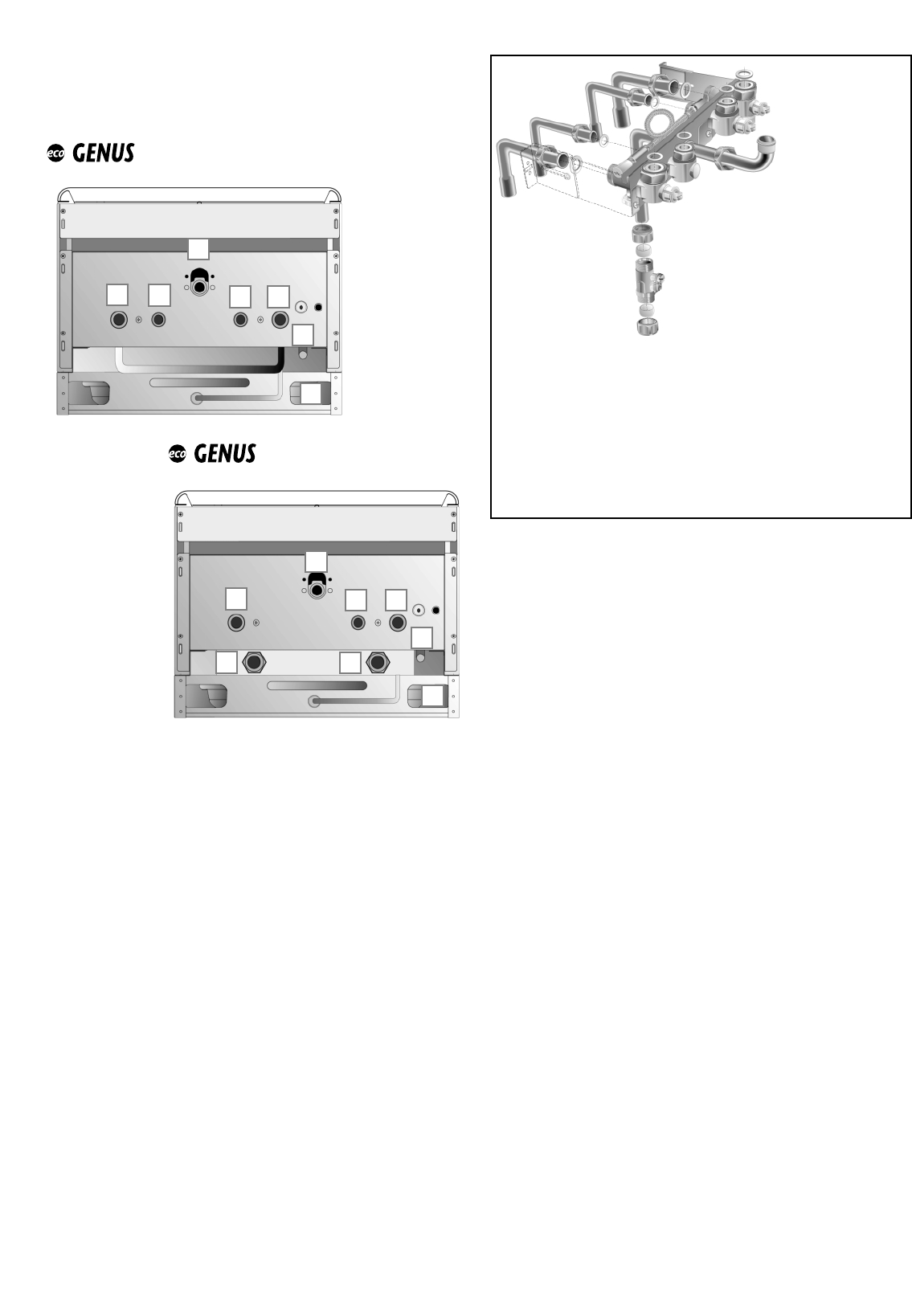
6
275
2.8. WATER CONNECTIONS
L
EGEND:
A = Central Heating Flow
B = Domestic Hot Water Outlet
C = Gas Inlet
D = Domestic Cold Water Inlet)
E = Central Heating Return
F = Cylinder Flow
G = Cylinder Return
H = Condensate discharge
I = Safety valve discharge
C
ENTRAL HEATING
Detailed recommendations are given in BS 6798:1987 and BS 5449-
1:1990, the following notes are given for general guidance.
P
IPE WORK:
Copper tubing to BS EN 1057:1996 is recommended for water
pipes. Jointing should be either with capillary soldered or
compression fittings.
Where possible pipes should have a gradient to ensure air is
carried naturally to air release points and water flows naturally to
drain taps.
The appliance has a built-in automatic air release valve, however
it should be ensured as far as possible that the appliance heat
exchanger is not a natural collecting point for air.
Except where providing useful heat, pipes should be insulated to
prevent heat loss and avoid freezing.
Particular attention should be paid to pipes passing through
ventilated spaces in roofs and under floors.
B
Y-PASS:
The appliance includes an automatic by-pass valve, which
protects the main heat exchanger in case of reduced or
interrupted water circulation through the heating system, due to
the closing of thermostatic valves or cock-type valves within the
system.
A
C
B
D E
I
A
C
G
D E
I
F
VIEW OF THE BOILER CONNECTIONS
FIG. 2.4
24 MFFI
24 MFFI SYSTEM
H
H
SYSTEM DESIGN:
This boiler is suitable only for sealed systems.
DRAIN COCKS:
These must be located in accessible positions to permit the
draining of the whole system. The taps must be at least 15mm
nominal size and manufactured in accordance with BS
2870:1980.
S
AFETY VALVE DISCHARGE:
The discharge should terminate facing downwards on the exterior
of the building in a position where discharging (possibly boiling
water & steam) will not create danger or nuisance, but in an easily
visible position, and not cause damage to electrical components
and wiring.
The discharge must not be over an entrance or a window or any
other type of public access.
C
ONDENSATE DISCHARGE:
The condensate discharge hose from the boiler must be inserted
by at least 50 mm into a suitable acid resistant pipe - e.g. plastic
waste or overflow pipe. The condensate discharge pipe must have
a continuous fall and preferably be installed and terminated within
the building to prevent freezing.
The discharge pipe must be terminated in a suitable position:
i) Connecting in to an internal soil stack (at least 450 mm above
the invert of the stack). A trap giving a water seal of at least 75
mm must be incorporated into the pipe run , there also must
be an air break upstream of the trap.
ii) Connecting into the waste system of the building such as a
washing machine or sink. The connection must be upstream of
the washing machine/sink (If the connection is down stream of
the waste trap then an additional trap giving a minimum water
seal of 75 mm and an air break must be incorporated in the
pipe run, as above.
iii) Terminating into a gully, below the grid level but above the
water level.
iv) Into a soakway.
N
OTE: If any condensate pipe work is to be installed externally,
then it should be kept to a minimum and be insulated with a
waterproof insulation and have a continuous fall.
A
IR RELEASE POINTS:
These must be fitted at all high points where air naturally collects
and must be sited to facilitate complete filling of the system.
The appliance has an integral sealed expansion vessel to
accommodate the increase of water value when the system is
heated.
It can accept up to 7 l (1.5 gal) of expansion water. If the heating
circuit has an unusually high water content, calculate the total
FIG. 2.5
Fitting the connection kit to
the ecoGENUS 24 RFFI
SYSTEM only.
It will be noted that the kit has
two connections not required
for this boiler i.e. the domestic
cold inlet “D” and the domestic
hot water outlet “B” (see fig.
2.4).
Although the cold water main supply must be connected to the
isolation valve for the purpose of operating the filling-loop, the
isolation valve is NOT connected to the boiler and should be left
in the OFF position.
The D.H.W. outlet is capped-off on the boiler, therefore not
requiring the isolation valve to be used.
The ecoGENUS 24 RFFI SYSTEM has 2 x 3/4" B.S.P. male
threads for the cylinder flow and return. It is recommended that 2
x 22mm x 3/4" female iron fittings (not supplied) be used on these
connections (using P.T.F.E. tape), before the boiler is mounted on
the wall.


















